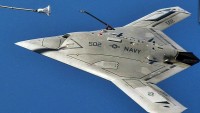US Navy Speeds-Up Program to Build Large Unmanned Combat Submarines
| Arthur Dominic Villasanta | | Jun 08, 2017 08:26 PM EDT |
(Photo : Boeing) Echo Voyager by Boeing.
In an indication the U.S. Navy is serious about building huge unmanned submarines to complement its manned submarine fleet, Huntington Ingalls, the navy's largest shipbuilder, has teamed-up with The Boeing Company, the largest aerospace defense firm, to build massive robot submarines.
Like Us on Facebook
Huntington Ingalls and Boeing will work on developing extra large unmanned undersea vehicles (XLUUVs), which will eventually become almost as large as manned attack submarines; just as heavily armed but without crews to keep out of harm's way.
These future XLUUvs will be far larger than the largest unmanned underwater vehicle (UUV) now being developed by Boeing -- the Eco Voyager, which is 17 meters long.
"This partnership provides the Navy a cost-effective, low-risk path to meet the emergent needs that prompted the Navy's Advanced Undersea Prototyping program," said Darryl Davis, president of Boeing Phantom Works.
"We are combining Boeing's preeminent (unmanned underwater vehicle) maritime engineering team with our nation's leading shipbuilder and Navy technical services company to get operational vehicles to the Navy years ahead of the standard acquisition process."
Echo Voyager, a 50 ton UUV, is currently being tested in the Pacific Ocean off California. Huntington Ingalls will bring its vast shipbuilding expertise to further improve this product.
The UUV can carry different kinds of payload modules. This capability allows Echo Voyager to accomplish different types of combat missions like launching anti-ship missiles; laying undersea mines or collecting data.
Echo Voyager is the newest member to join Boeing's unmanned undersea vehicle family. It's designed to stay underwater for months at a time.
Since the start of the year, U.S. military researchers began working with industry to develop an advanced undersea payload delivery system for XLUUVs. Among these payloads modules are persistent- weapons; surveillance sensors, or other UUVs and unmanned aerial vehicles (UAVs).
The U.S. Defense Advanced Research Projects Agency (DARPA) in March issued a broad agency announcement for the "Hunter Program" to develop a payload-delivery system from the XLUUV.
The Hunter program is a 45-month program in three phases: the first to design and build the payload delivery device to fit inside a government-provided payload module; and the second and third phases to support integration of the payload delivery device into the big UUV for testing.
TagsU.S. Navy, unmanned submarines, Huntington Ingalls, The Boeing Company, extra large unmanned undersea vehicles, XLUUVs, Eco Voyager, Defense Advanced Research Projects Agency, DARPA, Unmanned Underwater Vehicle, UUV
©2015 Chinatopix All rights reserved. Do not reproduce without permission
EDITOR'S PICKS
-

Did the Trump administration just announce plans for a trade war with ‘hostile’ China and Russia?
-

US Senate passes Taiwan travel bill slammed by China
-

As Yan Sihong’s family grieves, here are other Chinese students who went missing abroad. Some have never been found
-

Beijing blasts Western critics who ‘smear China’ with the term sharp power
-

China Envoy Seeks to Defuse Tensions With U.S. as a Trade War Brews
-

Singapore's Deputy PM Provides Bitcoin Vote of Confidence Amid China's Blanket Bans
-

China warns investors over risks in overseas virtual currency trading
-

Chinese government most trustworthy: survey
-

Kashima Antlers On Course For Back-To-Back Titles
MOST POPULAR
LATEST NEWS
Zhou Yongkang: China's Former Security Chief Sentenced to Life in Prison

China's former Chief of the Ministry of Public Security, Zhou Yongkang, has been given a life sentence after he was found guilty of abusing his office, bribery and deliberately ... Full Article
TRENDING STORY

China Pork Prices Expected to Stabilize As The Supplies Recover

Elephone P9000 Smartphone is now on Sale on Amazon India

There's a Big Chance Cliffhangers Won't Still Be Resolved When Grey's Anatomy Season 13 Returns

Supreme Court Ruled on Samsung vs Apple Dispute for Patent Infringement

Microsoft Surface Pro 5 Rumors and Release Date: What is the Latest?












